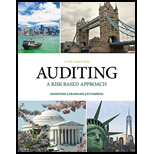
Auditing: A Risk Based-Approach (MindTap Course List)
11th Edition
ISBN: 9781337619455
Author: Karla M Johnstone, Audrey A. Gramling, Larry E. Rittenberg
Publisher: Cengage Learning
expand_more
expand_more
format_list_bulleted
Question
Chapter 6, Problem 11CYBK
To determine
Introduction: The procedures performed by an auditor to procure accuracy and reliability about the management’s assertion is known as substantive analytical procedures. Substantive analytical procedures are performed by an auditor based on their opinion about the effectiveness of company’s internal control.
The scenarios in which the analytical procedures are most appropriate as the substantive analytical procedures.
Expert Solution & Answer
Want to see the full answer?
Check out a sample textbook solution
Students have asked these similar questions
Define working capital and explain its importance in financial health and liquiditymanagement.2. Assess how the matching concept and accrual basis affect the reporting ofcurrent assets and liabilities.3. Using a hypothetical balance sheet (you may create one), identify at least 5current assets and 5 current liabilities and analyze how changes in theseelements affect liquidity ratios.4. Recommend at least two strategies to optimizeworking capital.
Discuss and explain the picture
Questi 7
Chapter 6 Solutions
Auditing: A Risk Based-Approach (MindTap Course List)
Ch. 6 - Prob. 1CYBKCh. 6 - Prob. 2CYBKCh. 6 - Prob. 3CYBKCh. 6 - Which of the following statements is true...Ch. 6 - Prob. 5CYBKCh. 6 - Prob. 6CYBKCh. 6 - Prob. 7CYBKCh. 6 - Prob. 8CYBKCh. 6 - Prob. 9CYBKCh. 6 - Prob. 10CYBK
Ch. 6 - Prob. 11CYBKCh. 6 - Prob. 12CYBKCh. 6 - Prob. 13CYBKCh. 6 - Prob. 14CYBKCh. 6 - Prob. 15CYBKCh. 6 - Prob. 16CYBKCh. 6 - Prob. 17CYBKCh. 6 - Prob. 18CYBKCh. 6 - Prob. 19CYBKCh. 6 - Prob. 20CYBKCh. 6 - Prob. 1RQSCCh. 6 - Prob. 2RQSCCh. 6 - Prob. 3RQSCCh. 6 - Prob. 4RQSCCh. 6 - Refer to Exhibit 6.2 and describe the differences...Ch. 6 - Prob. 6RQSCCh. 6 - Prob. 7RQSCCh. 6 - Prob. 8RQSCCh. 6 - Prob. 10RQSCCh. 6 - Prob. 11RQSCCh. 6 - Prob. 12RQSCCh. 6 - Prob. 13RQSCCh. 6 - Prob. 14RQSCCh. 6 - Prob. 15RQSCCh. 6 - Indicate how the auditor could use substantive...Ch. 6 - Prob. 17RQSCCh. 6 - Prob. 18RQSCCh. 6 - Prob. 19RQSCCh. 6 - Prob. 20RQSCCh. 6 - Prob. 21RQSCCh. 6 - Prob. 22RQSCCh. 6 - Prob. 23RQSCCh. 6 - Prob. 24RQSCCh. 6 - Prob. 25RQSCCh. 6 - Prob. 26RQSCCh. 6 - Prob. 27RQSCCh. 6 - Prob. 28RQSCCh. 6 - Prob. 29FFCh. 6 - Prob. 30FFCh. 6 - Prob. 31FFCh. 6 - Prob. 32FFCh. 6 - Prob. 33FFCh. 6 - MINISCRIBE (LO 1, 2) As reported in the Wall...
Knowledge Booster
Similar questions
- Financial accountingarrow_forwardBased on the attached amortization schedule, what is the amount for the interest expense and amortization expense that is missing from the ledger? 2 year term, 8 quarterly payments, 6% rate Initial lease $136768arrow_forwardSouthern Company leased high-tech electronic equipment from Edison Leasing on January 1, 2024. Edison purchased the equipment from International Machines at a cost of $136,768. 2 year lease, with 8 quarterly payments of $18,000 each, 6% interest rate. What is the amortization schedule for this loan starting Jan 1, 2024?arrow_forward
- Questi 8arrow_forwardPrice and Efficiency Variances (22 points) The Livingston Corporation manufactures lamps. It has set up the following standards per finished unit for direct materials and direct manufacturing labor: 「 Direct Materials: 10 lb. at $5.20 per lb. Direct Manufacturing Labor: 0.5 hour at $30 per hour $52 $15.00 The number of finished unit budgeted for January 2017 was 9,940; 9,900 units were actually produced. Actual Results in January 2017 were as follows: 1.200 Direct Materials: 97,500 lb. used Direct Manufacturing Labor: 4,900 hours budg $155,575 During the month, materials purchases amounts to 99,400 lb., at a total cost of $536,760. Input price variances are isolated upon purchase. Input efficiency variances are isolated at the time of usage. Requirement Computer the January 2017 price and efficiency variances of direct materials and direct manufacturing labor. (Put a U for Unfavorable and a F for Favorable variances) 53670 Actual Costs Incurred Costs (Actual Input Qty. Actual Input…arrow_forwardMaple Grove Trading presents the following financial information Description Operating Expenses Amount 60,000 Sales Returns and Allowances 7,000 Sales Discounts Sales Revenue Cost of Goods Sold 10,000 200,000 95,000 What is Maple Grove Trading's gross profit? a. $98,000 b. $85,000 c. $88,000 d. $75,000arrow_forward
arrow_back_ios
SEE MORE QUESTIONS
arrow_forward_ios
Recommended textbooks for you
 Auditing: A Risk Based-Approach (MindTap Course L...AccountingISBN:9781337619455Author:Karla M Johnstone, Audrey A. Gramling, Larry E. RittenbergPublisher:Cengage Learning
Auditing: A Risk Based-Approach (MindTap Course L...AccountingISBN:9781337619455Author:Karla M Johnstone, Audrey A. Gramling, Larry E. RittenbergPublisher:Cengage Learning Auditing: A Risk Based-Approach to Conducting a Q...AccountingISBN:9781305080577Author:Karla M Johnstone, Audrey A. Gramling, Larry E. RittenbergPublisher:South-Western College Pub
Auditing: A Risk Based-Approach to Conducting a Q...AccountingISBN:9781305080577Author:Karla M Johnstone, Audrey A. Gramling, Larry E. RittenbergPublisher:South-Western College Pub

Auditing: A Risk Based-Approach (MindTap Course L...
Accounting
ISBN:9781337619455
Author:Karla M Johnstone, Audrey A. Gramling, Larry E. Rittenberg
Publisher:Cengage Learning

Auditing: A Risk Based-Approach to Conducting a Q...
Accounting
ISBN:9781305080577
Author:Karla M Johnstone, Audrey A. Gramling, Larry E. Rittenberg
Publisher:South-Western College Pub